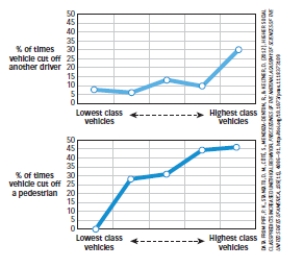Use the following to answer questions
Scenario I
Scenario I is based on and presents data from the following study (reproduced from p.25 of the textbook) :
Piff,P.K. ,Stancato,D.M. ,Côté,S. ,Mendoza-Denton,R. ,& Keltner,D.(2012) .Higher social class predicts increased unethical behavior.PNAS Proceedings of the National Academy of Sciences of the United States of America,109(11) ,4086-4091.doi:10.1073/pnas.1118373109
Piff and colleagues (2012) used naturalistic observation techniques to determine if wealthy people behaved more or less ethically than people who were not wealthy.In one study,observers stood at a busy intersection and recorded the make,model,and year of each approaching car.They also noted if the car cut off other cars or pedestrians at this intersection.
Major findings of Piff et al.(2012) are presented in Figure 1.1.This figure shows the percentage of times vehicles cut off another driver (top panel) or pedestrians (lower panel) as a function of the social status of the vehicles (with more expensive cars ranked higher in social status) .
Figure 1.1 
-(Scenario I) Consider only the top panel in Figure 1.1.These results underscore the importance of:
Definitions:
Overreward Inequity
A situation where an individual perceives they are getting more rewards than they believe they deserve compared to others.
Frustration-Regression
A psychological phenomenon observed in goal-oriented behavior, where an individual facing obstacles regresses to less mature behaviors or simpler strategies in order to deal with frustration.
Equity Theory
A theory in social psychology that explains how individuals perceive fairness in distribution of resources within interpersonal relationships, leading to satisfaction or dissatisfaction.
Needs Hierarchy Theory
A motivational theory proposing that humans have a hierarchy of five needs, ranging from basic physiological needs to self-actualization, which influence behavior.
Q59: Wilhelm Wundt first used reaction time to
Q79: Individuals suffering from visual neglect also demonstrate
Q89: The method of loci is a memory
Q98: Fluid intelligence is generally assessed by tests
Q171: Imaging studies examining language processing in the
Q186: (Scenario II)In the late 1800s,Sir Francis Galton
Q220: A person who has received damage to
Q274: Response is to stimulus as:<br>A)an e-mail notification
Q334: Functionalists depended on introspection to study subjective
Q427: Currently,the majority of people earning their PhD